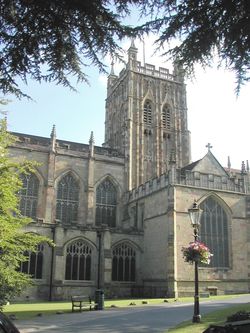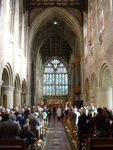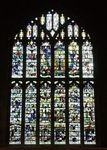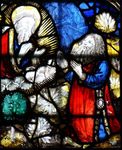The Great Malvern Priory

Without Great Malvern Priory it is safe to assume that Malvern as we know it would never have come into being. As Malvern’s oldest building, the Priory stands at the heart of the town that over the centuries grew up around it. The church has been a focus of prayer and worship in the centre of the Malvern Hills since its foundation stones were laid in ‘the wilderness of Malvern’ over 925 years ago. Founded in 1085 by Aldwin, a monk from Worcester, the Priory Church of St Mary and St Michael was built to serve the Benedictine monastery he established here during the reign of William the Conqueror.[1]
While the wonderfully sturdy pillars and arches of the nave date from the first Norman building, the external view of the church gives no hint of the early structure. Rebuilt entirely in the gothic perpendicular style during the 15th century, the Priory’s exterior is a striking blend of differing coloured stone, while the soaring tower is very similar in design to that of Gloucester Cathedral.
The 15th Century redevelopment was done on a grand scale. Within a period of about 60 years, all the windows were ornamented with magnificent stained glass from some of the finest workshops in the country. Two of the largest windows, the West and the North Transept, were donated by the successive and warring Kings Richard III and Henry VII. The transept window contains portraits of Henry VII and his short lived son and heir Prince Arthur. Today, Malvern Priory’s famous windows make up the most complete set of 15th century stained glass in any English parish church.
The Priory has two sets of fine medieval misericords, or Monk’s Stalls. The earlier group dates from the 14th century and includes carvings of mythical creatures such as a wyvern and mer-people, as well as scenes from everyday life. The second set depicts the labours of the months and was carved in the 15th century.
The manufacture of tiles at Malvern flourished during the 1400s. Produced in kilns just a few hundred yards from the Priory[2], 100 different designs survive and these now comprise one of the largest medieval tile collections in any parish church in England. [3]
During the dissolution of the Monasteries under Henry VIII it was only the intervention of the people of Malvern that saved this magnificent building from demolition. To buy the church they raised the then vast sum of £20, and so the Priory Monastery church became the Parish Church of Great Malvern.
After decades of neglect during the 18th century, major restoration work on the Priory began in 1860 under the direction of the famous architect Sir George Gilbert Scott.
In a fitting continuation of the Priory’s stained glass tradition, the Friends of Malvern Priory gave two new windows in 2004. Designed and created by Thomas Denny, these windows were inspired by Psalm 36 and were installed to mark the beginning of the Third Christian Millennium.
Great Malvern Priory today is home to a vibrant and committed church family. The story of the Priory and its people is one both of a building and of lives – ‘living stones’ - dedicated to the glory of God. Thousands of visitors enter the Priory each year to discover a welcoming, peaceful and beautiful church “adorned with varieties of rarities” as Civil War Parliamentarian officer Nehemiah Wharton described it in 1642.[4] Do come and see for yourself!
For information on Services, Events, History, People, Music and Tours please visit our website.





